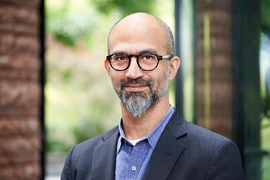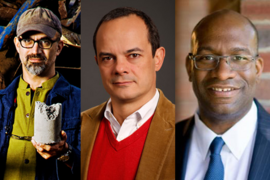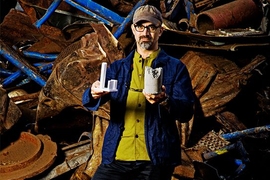Innovation needs the past, either to better what’s been or fill a void. Without that foundation, making solid decisions becomes nearly impossible. This thought is what caused Professor John Fernandez to create the Urban Metabolism Group at MIT and recently, with Research Scientist Phebe Dudek, the African Urban Metabolism (AUM) Network.
The director of the building technology program, and the recently named director of MIT's Environmental Solutions Initiative, has studied resource consumption around the world. “After spending a good deal of time understanding European and North American cities, Africa presented a critical opportunity for important impact on the ground,” Fernandez says. The continent has abundant materials but it faces an urban population boom and lacks sufficient infrastructure and capital investment. Its cities are already stressed, and climate change is just beginning to manifest. Before those issues can be addressed, the network has taken the initial steps of gathering relevant data, discovering where the opportunities are, and then sharing the information among city and business leaders, because, as he says, fewer things get noticed and implemented quicker than proven success in the field.
Creating a type
As an architect, Fernandez studies cities, specifically urban metabolism, looking at how intensely resources such as water, electricity, and food are used. While cities have been deeply analyzed in some ways, a systematic approach to overall urban consumption has been overlooked. The insight, though, is invaluable, because, “It’s pretty obvious that cities are the most complex and resource-intensive systems that humans have created,” he says.
Therefore, it’s necessary to better understand how usage is linked to urban activities and the infrastructure that provides services. To help give context, Fernandez has developed a global typology of 15 kinds of cities. The categorization helps to both distinguish between groups of cities that consume resources in similar ways and those that are quite distinct. As an example, cities in Norway, northern Alaska, and the Middle East are alike because of their role in regional economies with significant fossil fuel extraction.
The typology also highlights that developmental priorities and mitigating and adapting to climate change will have to be considered together. That’s a hallmark of the United Nations' new Sustainable Development Goals, says Fernandez, noting that in the global south, several city types demonstrate extremely low consumption of all resources while also urbanizing most rapidly. On the other hand, cities found in the developed north continue to consume resources a couple of orders of magnitude greater than cities in the global south.
The typology applies to all cities, and, as Fernandez says, better understanding Berlin or Paris metabolically is useful. But he has chosen to significantly focus on Africa as a region representing the challenges of the global south. The continent is resource rich, and while it’s not fully urbanized, it soon will be: Over the next 40 years, 90 percent of urban population growth will occur in cities of the global south, Fernandez says. Started in late 2014, the AUM Network will systematically analyze seven major areas — Nairobi, Lagos, Cape Town, Gauteng, Cairo, Kinshasa, and Luanda — with more cities to be added as the network expands.
Africa’s potential also brings challenges. Its resources might be abundant, but they’re underdeveloped. Cities on the continent have been understudied from a resource perspective, so there’s less quantifiable, sharable data than in the developed north. The largest cities are already struggling to maintain the existing infrastructure, so next steps toward a humane and sustainable future can seem daunting, Fernandez says.
Money is one significant problem, but an underlying issue, and a motivation for the network, is the absence of coordination. Many improvements in Africa have been incremental and isolated. Some stick and flourish, while others languish because of a lack of continued engagement. Fernandez says that the intent of the AUM Network is, as its name suggests, to create a network of academics, governances, and local and international businesses to develop and sustain momentum for projects in the long term.
Fernandez says that student researchers in each area will talk to key individuals in the field who know the issues, and each of them will become a local expert in characterizing the resource flows of a city. But, he adds, success will also come from sharing data and building consensus on a problem, most particularly by engaging the private sector over time. Ideas may be hatched in academia, but they’re implemented in the real world, and while needs will reveal themselves as the network grows, Fernandez says that it is already clear that opportunities exist in sectors that produce and deliver electricity, fuel, water, and renewable energy.
Seeing how the water runs
Along with continuing to develop city typologies, the network will be using resource flow mapping for the current set of seven partner cities. The approach is a combination of cartography and Sankey diagrams — which show resource flow — detailing the geographic locations of resource extraction and describing the volume of extraction and distribution rates. In essence, it’s an accounting system for consumption and waste, says Phebe Dudek.
As an example, consider water in Cairo and Egypt. The mapping shows local and national consumption rates, along with the source and distribution of treated and untreated wastewater. The visual data make certain things clear: Agriculture is the main water consumer in Egypt, but a number of informal consumption spots in Cairo have been unaccounted for in previous methods, Dudek says. “In fact, this is the most detailed accounting of Cairo water flows that is focused on the question of efficiency, and therefore highlights the enormous consumption of informal settlements; the slums and ‘illegal’ settlements,” Fernandez says.
The next step will be designing water systems that provide a reliable and adequate flow to these informal districts. Also, the mapping for water, as well as all the other resources, sets the stage for selecting and developing specific consumption technologies. “We see this as an opportunity to provide the foundation for engaging businesses, from building contractors to telecommunication companies, in leapfrogging obsolete infrastructure and providing more reliable and more efficient services,” he says.
The AUM Network has mapped five other resources in Egypt and Cairo: electricity, fossil fuels, industrial minerals and ores, construction materials, and biomass. Using different graphic techniques, maps can be compared, reveal gaps, and show possibilities for new projects. As the work develops, the mapping techniques should as well. Currently, while geographic information systems are the central toolkit, the hope is to incorporate various types of data like mobile phone technology for real-time consumption patterns and bottom-up data collection from consumers at the moment of purchase, Dudek says.
With any project, Fernandez says that research will be essential, but research is just the foundation. Peer-reviewed papers don’t often motivate leaders to make change. Their concern is mainly driving economic development and providing daily services, and, before they act, they want to see evidence of proven successes. The network reflects that reality. “We can insert the science and get to some really novel solutions, and do that in a way that enlists businesses from the very first,” Fernandez says, “because that’s the way that cities are going to change, not by way of the science alone. They’re going to change by way of integrated and transformational projects that can deliver success along multiple axes.”









